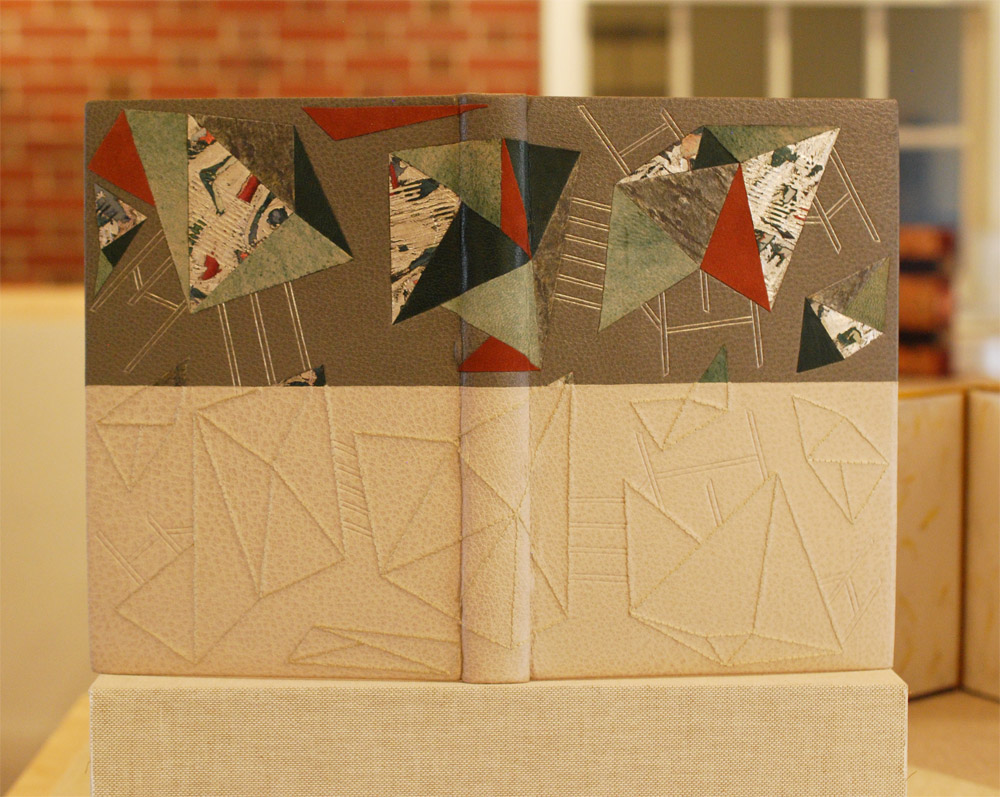In the second portion of my post on the Student and Alumni Exhibit at North Bennet Street School, I want to highlight some of the pieces showcasing the talents of our alumni. If you missed the post where I interviewed the graduating class on their set book, check it out here.
I’ll start with my own bindings. This year I chose to submit two recently completed bindings. The first is a miniature binding of Bobbie Sweeney’s Rookwood printed by Mosaic Press in 1983. The text chronicles the Rookwood Pottery studio founded in 1880 by Maria Longworth Nichols who fell in love with the Arts & Crafts movement. She and her employees pioneered a variety of different pottery styles and glazes over the course of Rookwood’s existence.
Bound in a Dorfner-style binding, the boards are covered with stone veneer with onlays of wood veneer and handmade paper. The interior side of the board is also covered in stone veneer facing a suede fly leaf. The edges have been sprinkled with purple gouache. The box is covered in dark grey buffalo skin with a back-pared onlay of light grey buffalo skin in one variation of the Rookwood insignia.
The second binding I chose to submit was completed just last month after working on it for over a year. This fine binding of Italo Calvino’s Invisible Cities is bound in two buffalo skins, with dark grey on top and light grey on the bottom. The top is adorned with a series of onlays in green goatskin (show in both leather and suede), ruby Novasuede, stone veneer and multilayered palladium gilt pieces. The bottom half is embroidered in a matching thread in such a way that partially mimics the top portion. All of the lines on the top are palladium tooled and the bottom are blind. I was greatly inspired by all of the imagery in Calvino’s abstract telling of a conservation between Kublai Khan and Marco Polo. I will be posting on this binding further, there is so much to reveal about the edge decoration and doublures.
Colin Urbina, BB’11
Next up is another lovely miniature, this one was bound by Colin Urbina.
Colin’s binding of Shaman is covered in a medium brown goatskin and adorned with onlays of stone veneer. Illustrations gleaned from the text are stamped in red foil. The head edge is sprinkled with red acrylic paint. The title is stamped in the same red foil along the spine of the book. The box for this miniature book is quite large because it holds the book, a paper folder of loose prints and a map (displayed open). The spine of the box is covered in a tan goatskin stamped in blind with the same icons from the book.
Samuel Feinstein, BB’12
As always, Samuel Feinstein impresses with his incredible tooling abilities. His binding of Dante Gabriel Rossetti’s Ballads and Sonnets is covered in a bright blue goatskin and intricate gold tooling. His work is always teetering on the line of classic design and modernism.
Gabby Cooksey, BB’14
The Book of Penumbra comes from the very talented Gabby Cooksey. Her work is always fresh and interesting and splendidly weird. The cover stands out in a unique way against the rest of the bindings and so does the technique. Gabby arranged the illustrations from the book in a chaotic way before debossing them into the black goatskin. Contrast is created through the application of varnish on the raised areas. The text block was also illustrated and printed by Gabby, you can read more about the work here.
Becky Koch, BB’12
My dear friend Becky Koch submitted this delightful little binding of The Farm by Wendell Berry. I love the array of colors she used to capture such a bucolic landscape.
The sun is beaming over the country side, literally beaming with Becky’s use surfacing gilding in gold leaf. Oh, I love that little patch of blue. Brilliantly place amongst a sea of mainly reds and browns. The title has been hand-tooled with carbon.
Fionnuala Gerrity, BB’ 11
Last up is Trinity is a small, but not quite miniature, laced vellum binding containing hand calligraphed pages from Maryanne Grebenstein. The transparent vellum reveals Fionnuala’s painting underneath.











Adorável. Gostaria muito de adquirir tal técnica. Sou admirador de trabalhos manuais.